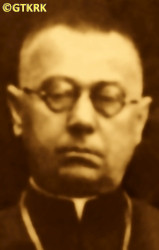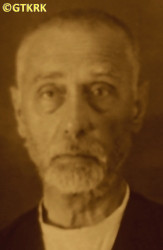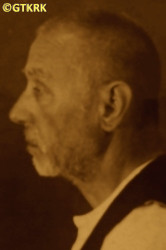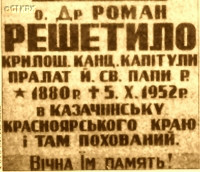Roman Catholic
St Sigismund parish
05-507 Słomczyn
85 Wiślana Str.
Konstancin deanery
Warsaw archdiocese, Poland
full list:
displayClick to display full list

searchClick to search full list by categories
wyświetlKliknij by wyświetlić pełną listę po polsku

szukajKliknij by przeszukać listę wg kategorii po polsku

Martyrology of the clergy — Poland
XX century (1914 – 1989)
personal data
surname
RESZETYŁO
forename(s)
Roman
function
eparchial priest
creed
Ukrainian Greek Catholic GCmore on
en.wikipedia.org
[access: 2013.05.19]
diocese / province
Przemyśl GC eparchymore on
pl.wikipedia.org
[access: 2013.05.19]
academic distinctions
Doctor of Theology
honorary titles
Papal chamberlainmore on
Papal chamberlain
Prelate‐provost (Lat. praelati‐praepositus)more on
Prelate—provost (Lat. praelati—praepositus)
(St Therese GC cathedral church, Przemyśltoday: Przemyśl city pov., Subcarpathia voiv., Poland
more on
en.wikipedia.org
[access: 2021.04.01])
Minor Canonmore on
Minor Canon
(St Therese GC cathedral church, Przemyśltoday: Przemyśl city pov., Subcarpathia voiv., Poland
more on
en.wikipedia.org
[access: 2021.04.01], St Therese GC cathedral church, Przemyśltoday: Przemyśl city pov., Subcarpathia voiv., Poland
more on
en.wikipedia.org
[access: 2021.04.01])
nationality
Ukrainian
date and place
of death
05.10.1952

Kazachinskoyetoday: Kazachinskoye, Kazachinskoye reg., Krasnoyarsk Krai, Russia
more on
en.wikipedia.org
[access: 2022.08.05]
details of death
After German and Russian invasion of Poland in 09.1939 and start of the World War II, after German defeat and start in 1944 of another Russian occupation, arrested on 26.06.1946 — during first round of deportation of Ukrainian population from Russian–controlled Polish prl state to Russian–occupied Ukraine and as part of the process of dissolution by the Russians of Greek Catholic Church — by Commie‐Nazi UB, Russian MGB (successor of genocidal Russian NKVD organization) unit, together with Abp Joseph Kocyłowski and Bp Gregory Łakota, and handed over to the Russians.
On 28.06.1946 arrived in Lviv and settled in nearby Kozyelnyky village.
There on 03.08.1946 formally arrested by the Russians.
Jailed in Lviv Łąckiego Str. prison and next in Lukyanivska prison in Kiev.
On the 10th day of interrogations fell ill and was taken to the prison hospital.
The interrogations started again on 04.12.1946.
Accused that „for many years was the lecturer at theological seminary and member of Przemyśl Curia chapter.
As such was implementing Vatican policies of formation of Greek Catholic priests and propagandists.
During lectures slandered Russian authorities and Communist party.
In 07.1941 took part in a German–Ukrainian nationalist meeting welcoming Germans in Przemyśl […] Was an active member of Vatican–founded anti–Russian Catholic Action organisation”.
On 21.02.1947 sentenced by the Russian MGB military kangaroo tribunal to 4 years of slave labour in Russian concentration camps Gulag.
Prob. held in ITL KrasLag concentration camp.
On 29.07.1950 released and exiled to Kazachinskoye village (Krasnoyarsk county), the place of deportation of, among others, many Poles at the turn of the 19th and 20th centuries, where slaved in a local kovkhoz, i.e. collective farm and where perished.
cause of death
extermination
perpetrators
Russians
sites and events
Forced exileClick to display the description, ITL KrasLagClick to display the description, GulagClick to display the description, Kiev (Lyukyanivska)Click to display the description, Lviv (Łąckiego)Click to display the description, Ribbentrop‐MolotovClick to display the description, Pius XI's encyclicalsClick to display the description
date and place
of birth
01.12.1880

Uhnivtoday: Belz urban hrom., Sheptytskyi rai., Lviv obl., Ukraine
more on
en.wikipedia.org
[access: 2020.11.24]
parents
RESZETYŁO John
🞲 ?, ? — 🕆 ?, ?

KOZŁOWSKA Catherine
🞲 ?, ? — 🕆 ?, ?
presbyter (holy orders)
ordination
08.09.1907

Przemyśltoday: Przemyśl city pov., Subcarpathia voiv., Poland
more on
en.wikipedia.org
[access: 2021.04.01]
St Therese GC cathedral churchmore on
en.wikipedia.org
[access: 2025.03.14]
positions held
from 03.1946
vicar general — Przemyśl GK eparchy
1935 – 1946
chancellor — Przemyśltoday: Przemyśl city pov., Subcarpathia voiv., Poland
more on
en.wikipedia.org
[access: 2021.04.01] ⋄ Cathedral Chapter ⋄ Nativity of St John the Baptist GC cathedral church
1928 – 1939
professor — Przemyśltoday: Przemyśl city pov., Subcarpathia voiv., Poland
more on
en.wikipedia.org
[access: 2021.04.01] ⋄ Greek Catholic Theological Seminary — also: lecturer of the Old Testament and Hebrew language
1922 – 1928
vice–rector — Przemyśltoday: Przemyśl city pov., Subcarpathia voiv., Poland
more on
en.wikipedia.org
[access: 2021.04.01] ⋄ Greek Catholic Theological Seminary — also: lecturer of the Old Testament and Hebrew language
from c. 1926
pro‐synodal judge — Przemyśltoday: Przemyśl city pov., Subcarpathia voiv., Poland
more on
en.wikipedia.org
[access: 2021.04.01] ⋄ Bishop's Eparchial Court ⋄ Przemyśl GK eparchy — also: defender of the marriage bond (from 1932)
from c. 1926
pro‐synodal examiner — Przemyśltoday: Przemyśl city pov., Subcarpathia voiv., Poland
more on
en.wikipedia.org
[access: 2021.04.01] ⋄ Eparchial Consistory (i.e. Curia) ⋄ Przemyśl GK eparchy
1925 – 1935
Minor Canon — Przemyśltoday: Przemyśl city pov., Subcarpathia voiv., Poland
more on
en.wikipedia.org
[access: 2021.04.01] ⋄ Cathedral Chapter ⋄ Nativity of St John the Baptist GC cathedral church
c. 1924 – c. 1928
counselor and clerk — Przemyśltoday: Przemyśl city pov., Subcarpathia voiv., Poland
more on
en.wikipedia.org
[access: 2021.04.01] ⋄ Eparchial Consistory (i.e. Curia) ⋄ Przemyśl GK eparchy
1922 – 1927
dean — Rava‐Ruskatoday: Rava‐Ruska urban hrom., Lviv rai., Lviv obl., Ukraine
more on
en.wikipedia.org
[access: 2022.01.16] GC deanery
1922 – 1927
parish priest — Potelychtoday: Rava‐Ruska urban hrom., Lviv rai., Lviv obl., Ukraine
more on
uk.wikipedia.org
[access: 2022.08.08] ⋄ Nativity of the Blessed Virgin Mary GC parish ⋄ Rava‐Ruskatoday: Rava‐Ruska urban hrom., Lviv rai., Lviv obl., Ukraine
more on
en.wikipedia.org
[access: 2022.01.16] GC deanery
1921 – 1922
administrator — Potelychtoday: Rava‐Ruska urban hrom., Lviv rai., Lviv obl., Ukraine
more on
uk.wikipedia.org
[access: 2022.08.08] ⋄ Nativity of the Blessed Virgin Mary GC parish ⋄ Rava‐Ruskatoday: Rava‐Ruska urban hrom., Lviv rai., Lviv obl., Ukraine
more on
en.wikipedia.org
[access: 2022.01.16] GC deanery
1920 – 1921
spiritual chaplain — Przemyśltoday: Przemyśl city pov., Subcarpathia voiv., Poland
more on
en.wikipedia.org
[access: 2021.04.01] ⋄ Greek Catholic Theological Seminary
1915 – 1920
prefect — Sanoktoday: Sanok urban gm., Sanok pov., Subcarpathia voiv., Poland
more on
en.wikipedia.org
[access: 2021.10.09] ⋄ Gymnasium [i.e. State Gymnasium (1918‐1922) / Imperial Gymnasium (till 1918)] ⋄ Holy Trinity GC parish ⋄ Sanoktoday: Sanok urban gm., Sanok pov., Subcarpathia voiv., Poland
more on
en.wikipedia.org
[access: 2021.10.09] GC deanery
1912 – 1914
curatus/rector/expositus — Telyazhtoday: Sokal urban hrom., Sheptytskyi rai., Lviv obl., Ukraine
more on
uk.wikipedia.org
[access: 2023.03.02] ⋄ Presentation of the Blessed Virgin Mary GC church ⋄ Ulvivoktoday: Sokal urban hrom., Sheptytskyi rai., Lviv obl., Ukraine
more on
uk.wikipedia.org
[access: 2023.03.02], Assumption of the Blessed Virgin Mary GC parish ⋄ Varyazhtoday: Sokal urban hrom., Sheptytskyi rai., Lviv obl., Ukraine
more on
en.wikipedia.org
[access: 2020.11.22] GC deanery
membership — Ukrainian Theological Society
1907 – 1911
PhD student — Viennatoday: Vienna state, Austria
more on
en.wikipedia.org
[access: 2020.07.31] ⋄ theology, St Augustine Higher Scientific Institute for Diocesan Priests („Augustineum/Frintaneum”) — PhD thesis Lat. „Jus successionis hereditariae vindicetur et exponatur” (Eng. „The right of hereditary succession is claimed and explained”), public defense on 08.07.1911
till c. 1907
student — Przemyśltoday: Przemyśl city pov., Subcarpathia voiv., Poland
more on
en.wikipedia.org
[access: 2021.04.01] ⋄ philosophy and theology, Greek Catholic Theological Seminary
student — Lvivtoday: Lviv urban hrom., Lviv rai., Lviv obl., Ukraine
more on
en.wikipedia.org
[access: 2022.01.16] ⋄ philosophy and theology, Greek Catholic Theological Seminary
others related
in death
KOCYŁOWSKIClick to display biography Joseph (Bp Josaphat), ŁAKOTAClick to display biography Gregory, KASZUBSKIClick to display biography Victor, MARKUSZEWSKIClick to display biography Albin, WASILEWSKIClick to display biography John
sites and events
descriptions
Forced exile: One of the standard Russian forms of repression. The prisoners were usually taken to a small village in the middle of nowhere — somewhere in Siberia, in far north or far east — dropped out of the train carriage or a cart, left out without means of subsistence or place to live. (more on: en.wikipedia.orgClick to attempt to display webpage
[access: 2014.12.20])
ITL KrasLag: Russian Rus. Исправи́тельно‐Трудово́й Ла́герь (Eng. Corrective Labor Camp) ITL Rus. Красноярский (Eng. Krasnoyarskiy) — concentration and slave forced labor camp (within the Gulag complex) — headquartered in Kansk, and later at the Reshoty station in Nizhnyaya Poyma in the Krasnoyarsk Krai. Founded on 05.02.1938. Prisoners slaved at the forest clearing and wood processing (ski semi‐finished products, production of skis, furniture, railway sleepers), construction of a hydrolysis plant in Kańsk, completion of the construction of railway lines to the ITL AngarLag concentration camp, in agricultural works, in the construction of apartments and roads, production of bricks, etc. At its peak — till the death on 05.03.1953 of Russian socialist leader, Joseph Stalin — c. 31,000 prisoners were held there: e.g. 22,686 (01.01.1942); 23,900 (01.01.1948); 30,007 (01.01.1950); 23,345 (01.01.1951); 26,481 (01.01.1952); 26,611 (01.04.1952); 30,546 (01.01.1953). By 1950 over 100,000 prisoners had passed through it. In the years 1938‐1939 and 1941‐1945, the annual mortality rate was c. 7‐8% of those imprisoned (some were shot). Among the prisoners were many Lithuanians (from 1941) and Volga Germans (from 01.1942). In the second half of the 1940s many political prisoners from Ukraine and Belarus were brought to the camps. Ceased to operate in 1960, though already in 1949‐1950 some of the prisoners were relocated to other concentration camps, to ITL StepLag in Kazachstan among others. (more on: old.memo.ruClick to attempt to display webpage
[access: 2024.04.08])
Gulag: The acronym Gulag comes from the Rus. Главное управление исправительно‐трудовых лагерей и колоний (Eng. Main Board of Correctional Labor Camps). The network of Russian concentration camps for slave labor was formally established by the decision of the highest Russian authorities on 27.06.1929. Control was taken over by the OGPU, the predecessor of the genocidal NKVD (from 1934) and the MGB (from 1946). Individual gulags (camps) were often established in remote, sparsely populated areas, where industrial or transport facilities important for the Russian state were built. They were modeled on the first „great construction of communism”, the White Sea‐Baltic Canal (1931‐1932), and Naftali Frenkel, of Jewish origin, is considered the creator of the system of using forced slave labor within the Gulag. He went down in history as the author of the principle „We have to squeeze everything out of the prisoner in the first three months — then nothing is there for us”. He was to be the creator, according to Alexander Solzhenitsyn, of the so‐called „Boiler system”, i.e. the dependence of food rations on working out a certain percentage of the norm. The term ZEK — prisoner — i.e. Rus. заключенный‐каналоармец (Eng. canal soldier) — was coined in the ITL BelBaltLag managed by him, and was adopted to mean a prisoner in Russian slave labor camps. Up to 12 mln prisoners were held in Gulag camps at one time, i.e. c. 5% of Russia's population. In his book „The Gulag Archipelago”, Solzhenitsyn estimated that c. 60 mln people were killed in the Gulag until 1956. Formally dissolved on 20.01.1960. (more on: en.wikipedia.orgClick to attempt to display webpage
[access: 2024.04.08])
Kiev (Lyukyanivska): Russian political prison in Kiev, in the first half of 20th century run by the genocidal NKVD, informally referred to as prison No 1, formally as Investigative Prison No 13 (SIZO#13). It was founded in the early 19th century. In the 20th century, during the Soviet times, the prison church was transformed into another block of cells. During the reign of J. Stalin in Russia, more than 25,000 prisoners passed through it. (more on: en.wikipedia.orgClick to attempt to display webpage
[access: 2014.09.21])
Lviv (Łąckiego): Prison at Łącki Str. in Lviv. Founded in 1918‐1920 by Polish authorities, mainly for political prisoners. From 1935 used as investigative jail. After German and Russian invasion of Poland in 09.1939 and start of the World War II, after start of Russian occupation Russians — local branch of Russian genocidal NKVD organisation — held thousands of prisoners, mainly Poles and Ukrainians, in prison (then prison no 1). It was also a place of carrying out death sentences passed by Russian summary courts on Poles suspected of participation in Polish clandestine resistance activities. In 06.1941, after German attack on 22.06.1941 of their erstwhile ally, Russians, NKVD agents slaugher — during genocidal massacres of prisoners — c. 924 inmates. During German occupation that followed in 1941‐1944 the prison’s buildings held German Gestapo investigative jail. It was a place of executions. In 1944‐1991, after German defeat and start of another Russian occupation, the building were again used by NKVD (and it successor MVD) as investigative jail and also investigative department. (more on: pl.wikipedia.orgClick to attempt to display webpage
[access: 2014.10.31])
Ribbentrop‐Molotov: Genocidal Russian‐German alliance pact between Russian leader Joseph Stalin and German leader Adolf Hitler signed on 23.08.1939 in Moscow by respective foreign ministers, Mr. Vyacheslav Molotov for Russia and Joachim von Ribbentrop for Germany. The pact sanctioned and was the direct cause of joint Russian and German invasion of Poland and the outbreak of the World War II in 09.1939. In a political sense, the pact was an attempt to restore the status quo ante before 1914, with one exception, namely the „commercial” exchange of the so‐called „Kingdom of Poland”, which in 1914 was part of the Russian Empire, fore Eastern Galicia (today's western Ukraine), in 1914 belonging to the Austro‐Hungarian Empire. Galicia, including Lviv, was to be taken over by the Russians, the „Kingdom of Poland” — under the name of the General Governorate — Germany. The resultant „war was one of the greatest calamities and dramas of humanity in history, for two atheistic and anti‐Christian ideologies — national and international socialism — rejected God and His fifth Decalogue commandment: Thou shall not kill!” (Abp Stanislav Gądecki, 01.09.2019). The decisions taken — backed up by the betrayal of the formal allies of Poland, France and Germany, which on 12.09.1939, at a joint conference in Abbeville, decided not to provide aid to attacked Poland and not to take military action against Germany (a clear breach of treaty obligations with Poland) — were on 28.09.1939 slightly altered and made more precise when a treaty on „German‐Russian boundaries and friendship” was agreed by the same murderous signatories. One of its findings was establishment of spheres of influence in Central and Eastern Europe and in consequence IV partition of Poland. In one of its secret annexes agreed, that: „the Signatories will not tolerate on its respective territories any Polish propaganda that affects the territory of the other Side. On their respective territories they will suppress all such propaganda and inform each other of the measures taken to accomplish it”. The agreements resulted in a series of meeting between two genocidal organization representing both sides — German Gestapo and Russian NKVD when coordination of efforts to exterminate Polish intelligentsia and Polish leading classes (in Germany called «Intelligenzaktion», in Russia took the form of Katyń massacres) where discussed. Resulted in deaths of hundreds of thousands of Polish intelligentsia, including thousands of priests presented here, and tens of millions of ordinary people,. The results of this Russian‐German pact lasted till 1989 and are still in evidence even today. (more on: en.wikipedia.orgClick to attempt to display webpage
[access: 2015.09.30])
Pius XI's encyclicals: Facing the creation of two totalitarian systems in Europe, which seemed to compete with each other, though there were more similarities than contradictions between them, Pope Pius XI issued in 03.1937 (within 5 days) two encyclicals. In the „Mit brennender Sorge” (Eng. „With Burning Concern”) published on 14.03.1938, condemned the national socialism prevailing in Germany. The Pope wrote: „Whoever, following the old Germanic‐pre‐Christian beliefs, puts various impersonal fate in the place of a personal God, denies the wisdom of God and Providence […], whoever exalts earthly values: race or nation, or state, or state system, representatives of state power or other fundamental values of human society, […] and makes them the highest standard of all values, including religious ones, and idolizes them, this one […] is far from true faith in God and from a worldview corresponding to such faith”. On 19.03.1937, published „Divini Redemptoris” (Eng. „Divine Redeemer”), in which criticized Russian communism, dialectical materialism and the class struggle theory. The Pope wrote: „Communism deprives man of freedom, and therefore the spiritual basis of all life norms. It deprives the human person of all his dignity and any moral support with which he could resist the onslaught of blind passions […] This is the new gospel that Bolshevik and godless communism preaches as a message of salvation and redemption of humanity”… Pius XI demanded that the established human law be subjected to the natural law of God , recommended the implementation of the ideal of a Christian state and society, and called on Catholics to resist. Two years later, National Socialist Germany and Communist Russia came together and started World War II. (more on: www.vatican.vaClick to attempt to display webpage
[access: 2023.05.28], www.vatican.vaClick to attempt to display webpage
[access: 2023.05.28])
sources
personal:
www.vox-populi.com.uaClick to attempt to display webpage
[access: 2015.03.01]
bibliographical:
„Clergy of Przemyśl Eparchy and Apostolic Exarchate of Lemkivshchyna”, Bogdan Prach, Ukrainian Catholic University Publishing House, Lviv 2015
original images:
ucu.edu.uaClick to attempt to display webpage
[access: 2020.01.06], ucu.edu.uaClick to attempt to display webpage
[access: 2020.01.06], www.vox-populi.com.uaClick to attempt to display webpage
[access: 2015.03.01]
LETTER to CUSTODIAN/ADMINISTRATOR
If you have an Email client on your communicator/computer — such as Mozilla Thunderbird, Windows Mail or Microsoft Outlook, described at WikipediaPatrz:
en.wikipedia.org, among others — try the link below, please:
LETTER to CUSTODIAN/ADMINISTRATORClick and try to call your own Email client
If however you do not run such a client or the above link is not active please send an email to the Custodian/Administrator using your account — in your customary email/correspondence engine — at the following address:

giving the following as the subject:
MARTYROLOGY: RESZETYŁO Roman
To return to the biography press below:
 Click to return to biography
Click to return to biography











